LEXUS RX350 2011 Owners Manual
Manufacturer: LEXUS, Model Year: 2011, Model line: RX350, Model: LEXUS RX350 2011Pages: 821, PDF Size: 13.27 MB
Page 541 of 821

471
4-3. Do-it-yourself maintenance
4
Maintenance and care
nIf the coolant level drops within a short time after replenishing
Visually check the radiator, hoses, radiator cap, drain cock and water pump.
If you cannot find a leak, have your Lexus dealer test the cap and check for leaks in
the cooling systems.
CAUTION
nWhen the engine is hot
Do not remove the radiator cap.
The cooling system may be under pressure and may spray hot coolant if the cap is
removed, causing burns or other injuries.
NOTICE
nWhen adding engine coolant
Coolant is neither plain water nor straight antifreeze. The correct mixture of water
and antifreeze must be used to provide proper lubrication, corrosion protection
and cooling. Be sure to read the antifreeze or coolant label.
nIf you spill coolant
Be sure to wash it off with water to prevent damage to parts or paint.
Page 542 of 821
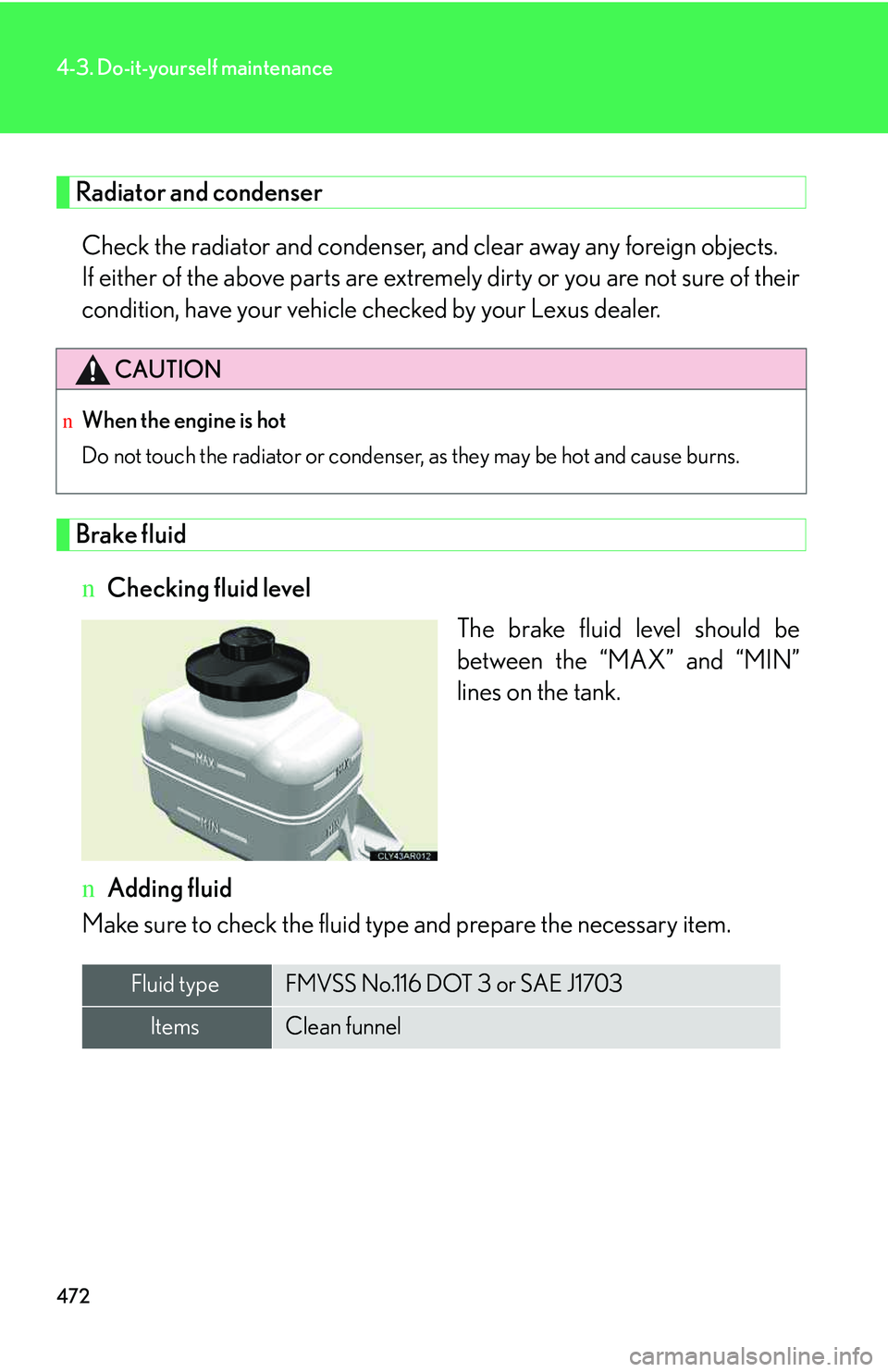
472
4-3. Do-it-yourself maintenance
Radiator and condenser
Check the radiator and condenser, and clear away any foreign objects.
If either of the above parts are extremely dirty or you are not sure of their
condition, have your vehicle checked by your Lexus dealer.
Brake fluid
nChecking fluid level
The brake fluid level should be
between the “MAX” and “MIN”
lines on the tank.
nAdding fluid
Make sure to check the fluid type and prepare the necessary item.
CAUTION
nWhen the engine is hot
Do not touch the radiator or condenser, as they may be hot and cause burns.
Fluid typeFMVSS No.116 DOT 3 or SAE J1703
ItemsClean funnel
Page 543 of 821
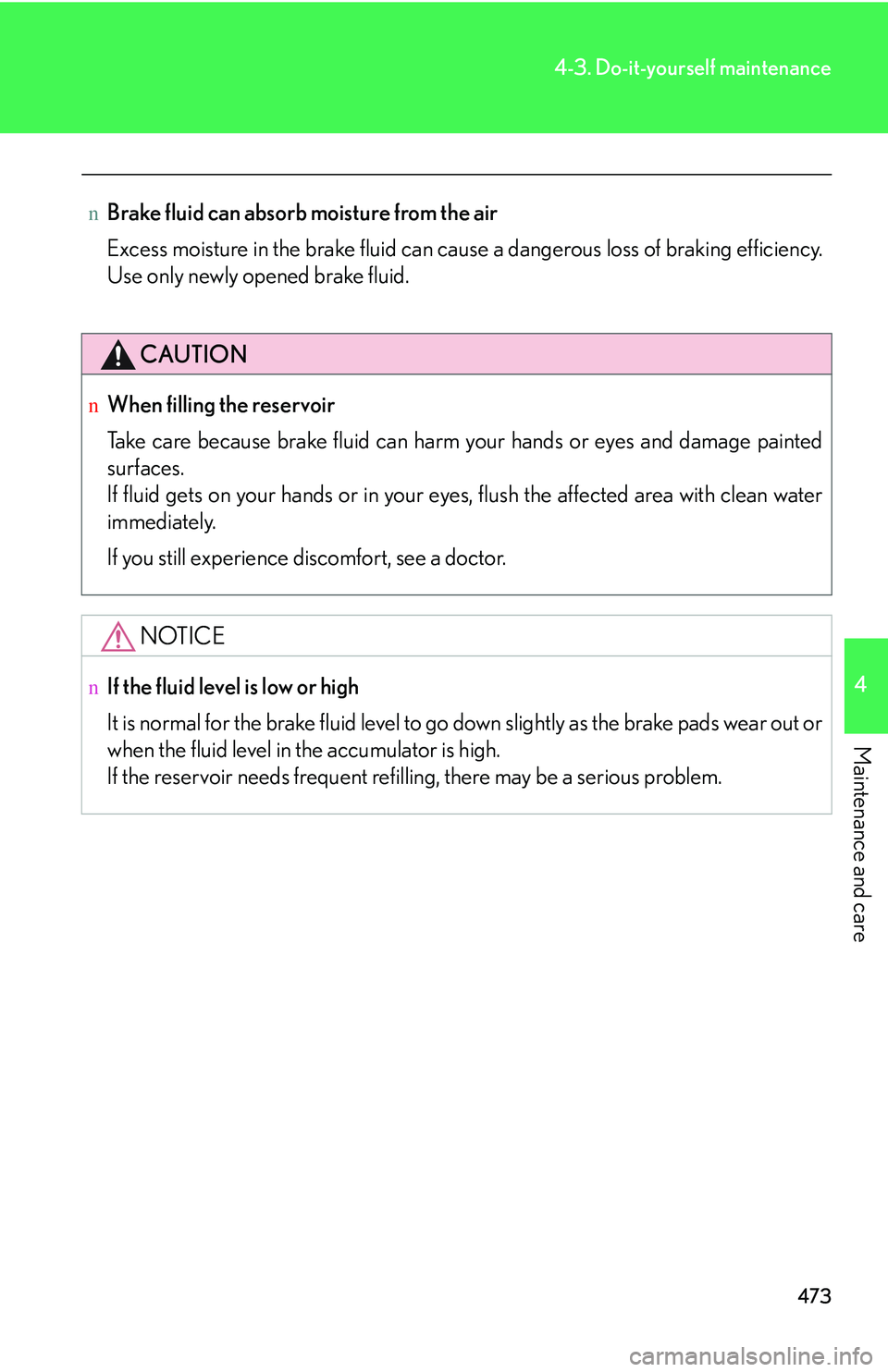
473
4-3. Do-it-yourself maintenance
4
Maintenance and care
nBrake fluid can absorb moisture from the air
Excess moisture in the brake fluid can cause a dangerous loss of braking efficiency.
Use only newly opened brake fluid.
CAUTION
nWhen filling the reservoir
Take care because brake fluid can harm your hands or eyes and damage painted
surfaces.
If fluid gets on your hands or in your eyes, flush the affected area with clean water
immediately.
If you still experience discomfort, see a doctor.
NOTICE
nIf the fluid level is low or high
It is normal for the brake fluid level to go down slightly as the brake pads wear out or
when the fluid level in the accumulator is high.
If the reservoir needs frequent refilling, there may be a serious problem.
Page 544 of 821
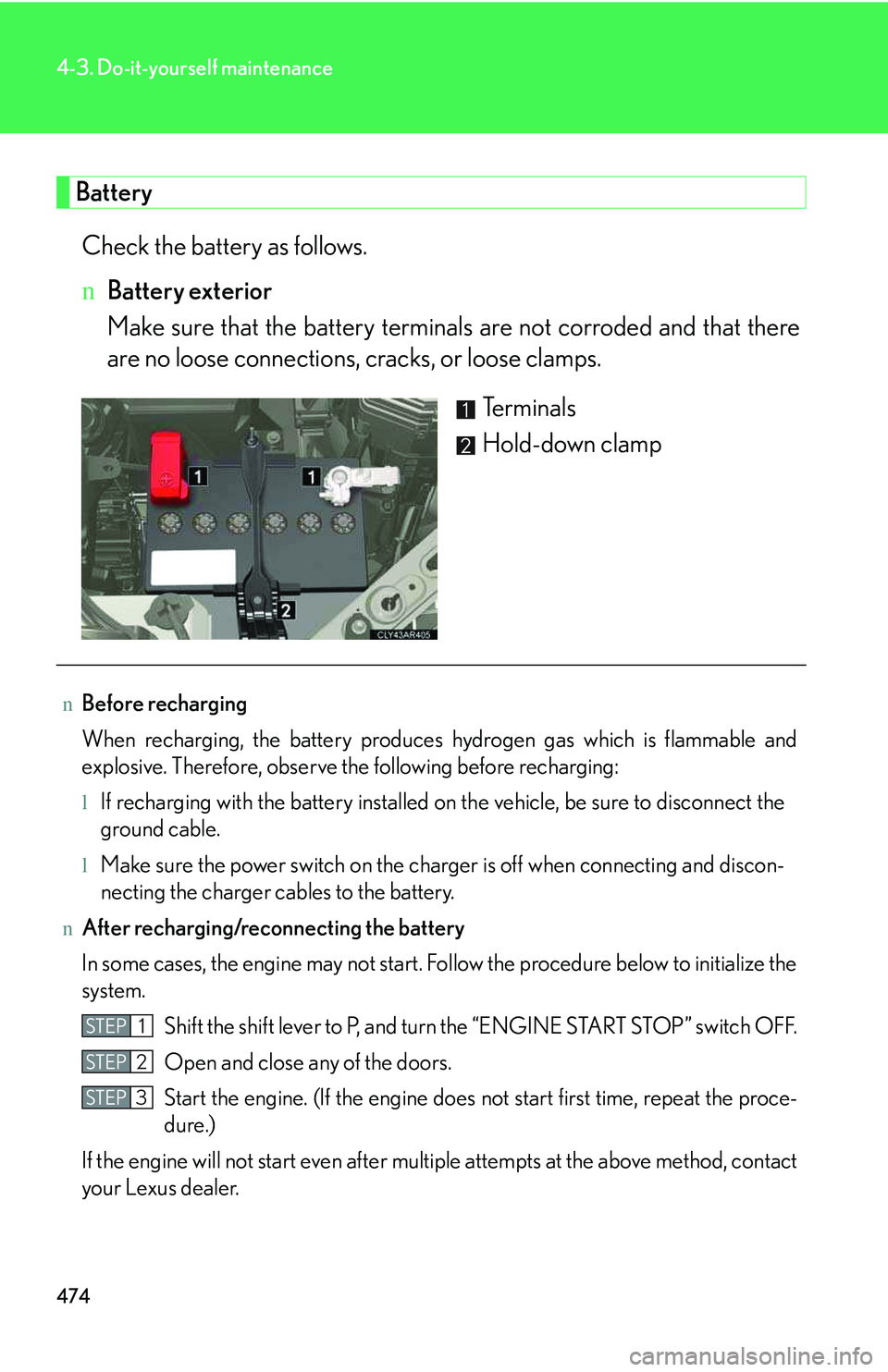
474
4-3. Do-it-yourself maintenance
Battery
Check the battery as follows.
nBattery exterior
Make sure that the battery terminals are not corroded and that there
are no loose connections, cracks, or loose clamps.
Terminals
Hold-down clamp
nBefore recharging
When recharging, the battery produces hydrogen gas which is flammable and
explosive. Therefore, observe the following before recharging:
lIf recharging with the battery installed on the vehicle, be sure to disconnect the
ground cable.
lMake sure the power switch on the charger is off when connecting and discon-
necting the charger cables to the battery.
nAfter recharging/reconnecting the battery
In some cases, the engine may not start. Follow the procedure below to initialize the
system.
Shift the shift lever to P, and turn the “ENGINE START STOP” switch OFF.
Open and close any of the doors.
Start the engine. (If the engine does not start first time, repeat the proce-
dure.)
If the engine will not start even after multiple attempts at the above method, contact
your Lexus dealer.
STEP1
STEP2
STEP3
Page 545 of 821
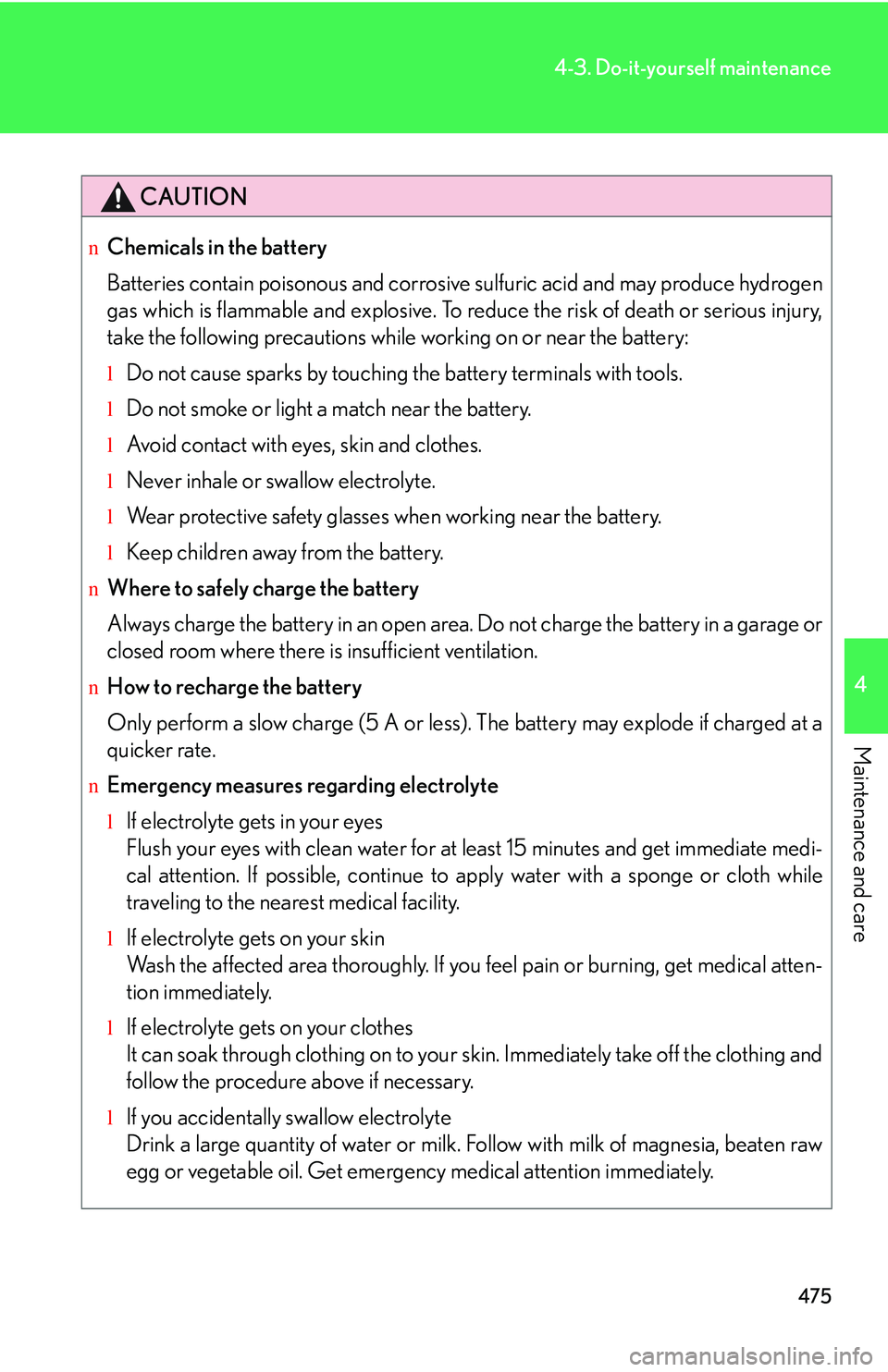
475
4-3. Do-it-yourself maintenance
4
Maintenance and care
CAUTION
nChemicals in the battery
Batteries contain poisonous and corrosive sulfuric acid and may produce hydrogen
gas which is flammable and explosive. To reduce the risk of death or serious injury,
take the following precautions while working on or near the battery:
lDo not cause sparks by touching the battery terminals with tools.
lDo not smoke or light a match near the battery.
lAvoid contact with eyes, skin and clothes.
lNever inhale or swallow electrolyte.
lWear protective safety glasses when working near the battery.
lKeep children away from the battery.
nWhere to safely charge the battery
Always charge the battery in an open area. Do not charge the battery in a garage or
closed room where there is insufficient ventilation.
nHow to recharge the battery
Only perform a slow charge (5 A or less). The battery may explode if charged at a
quicker rate.
nEmergency measures regarding electrolyte
lIf electrolyte gets in your eyes
Flush your eyes with clean water for at least 15 minutes and get immediate medi-
cal attention. If possible, continue to apply water with a sponge or cloth while
traveling to the nearest medical facility.
lIf electrolyte gets on your skin
Wash the affected area thoroughly. If you feel pain or burning, get medical atten-
tion immediately.
lIf electrolyte gets on your clothes
It can soak through clothing on to your skin. Immediately take off the clothing and
follow the procedure above if necessary.
lIf you accidentally swallow electrolyte
Drink a large quantity of water or milk. Follow with milk of magnesia, beaten raw
egg or vegetable oil. Get emergency medical attention immediately.
Page 546 of 821
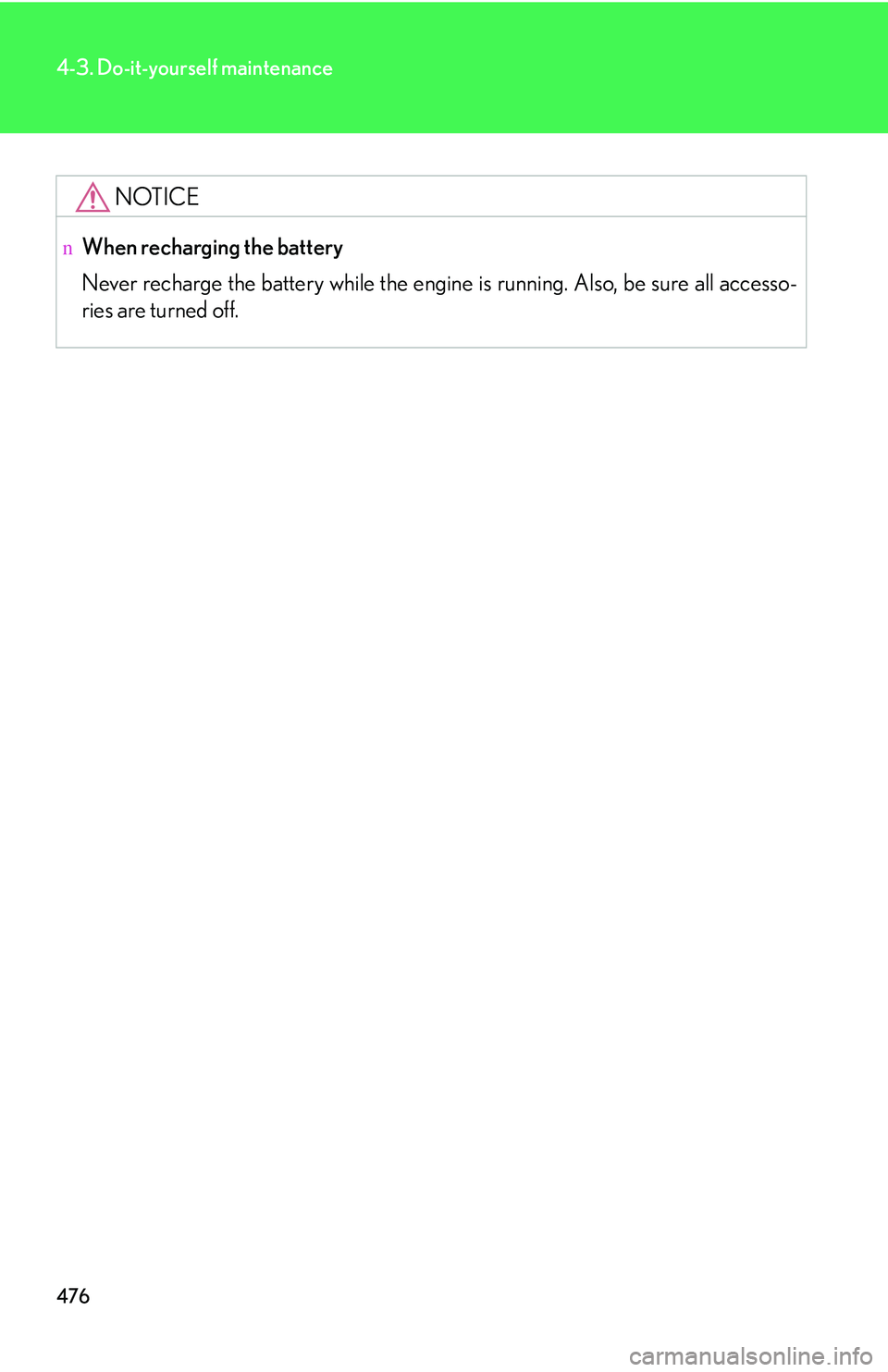
476
4-3. Do-it-yourself maintenance
NOTICE
nWhen recharging the battery
Never recharge the battery while the engine is running. Also, be sure all accesso-
ries are turned off.
Page 547 of 821
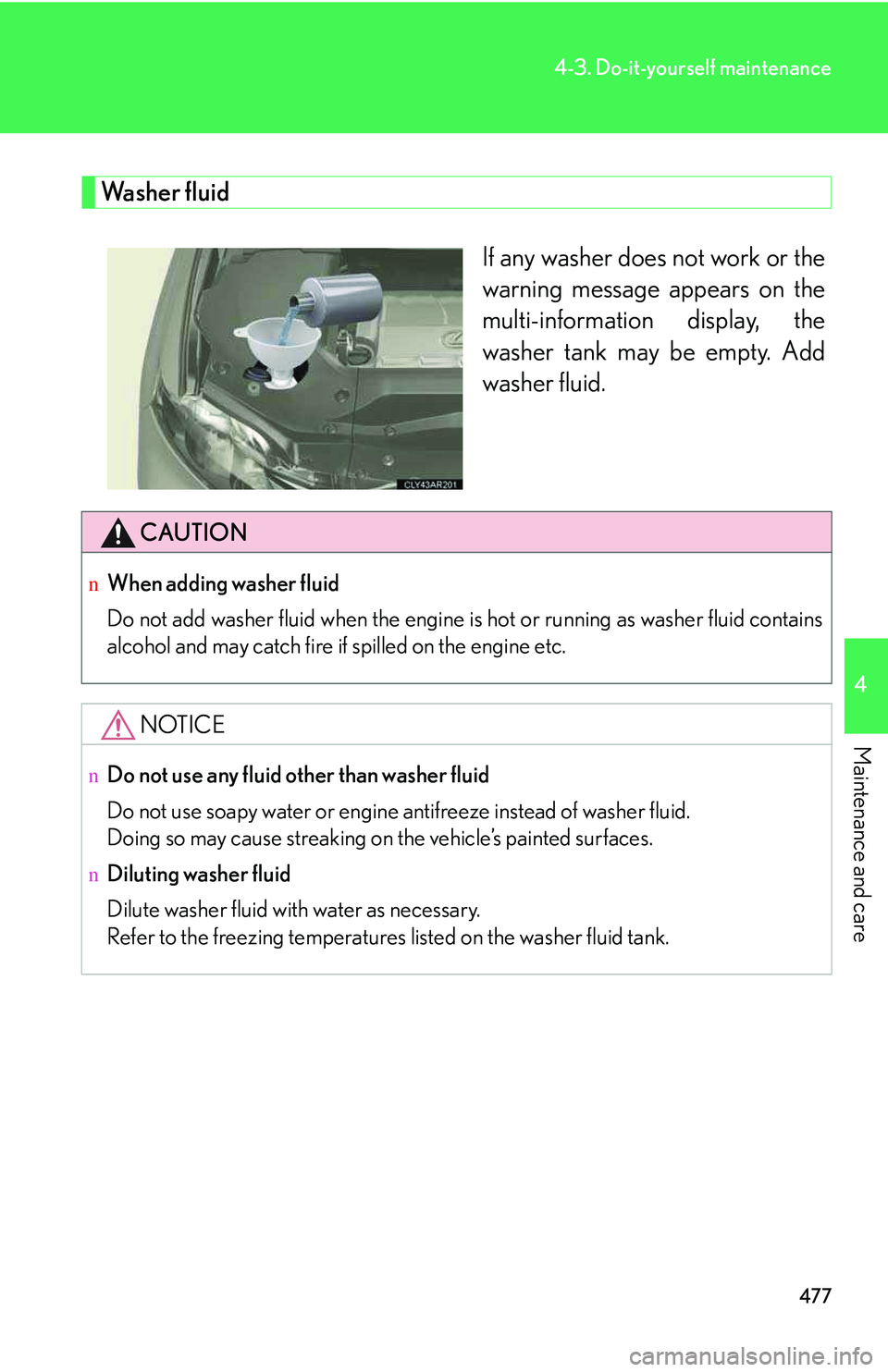
477
4-3. Do-it-yourself maintenance
4
Maintenance and care
Washer fluid
If any washer does not work or the
warning message appears on the
multi-information display, the
washer tank may be empty. Add
washer fluid.
CAUTION
nWhen adding washer fluid
Do not add washer fluid when the engine is hot or running as washer fluid contains
alcohol and may catch fire if spilled on the engine etc.
NOTICE
nDo not use any fluid other than washer fluid
Do not use soapy water or engine antifreeze instead of washer fluid.
Doing so may cause streaking on the vehicle’s painted surfaces.
nDiluting washer fluid
Dilute washer fluid with water as necessary.
Refer to the freezing temperatures listed on the washer fluid tank.
Page 548 of 821
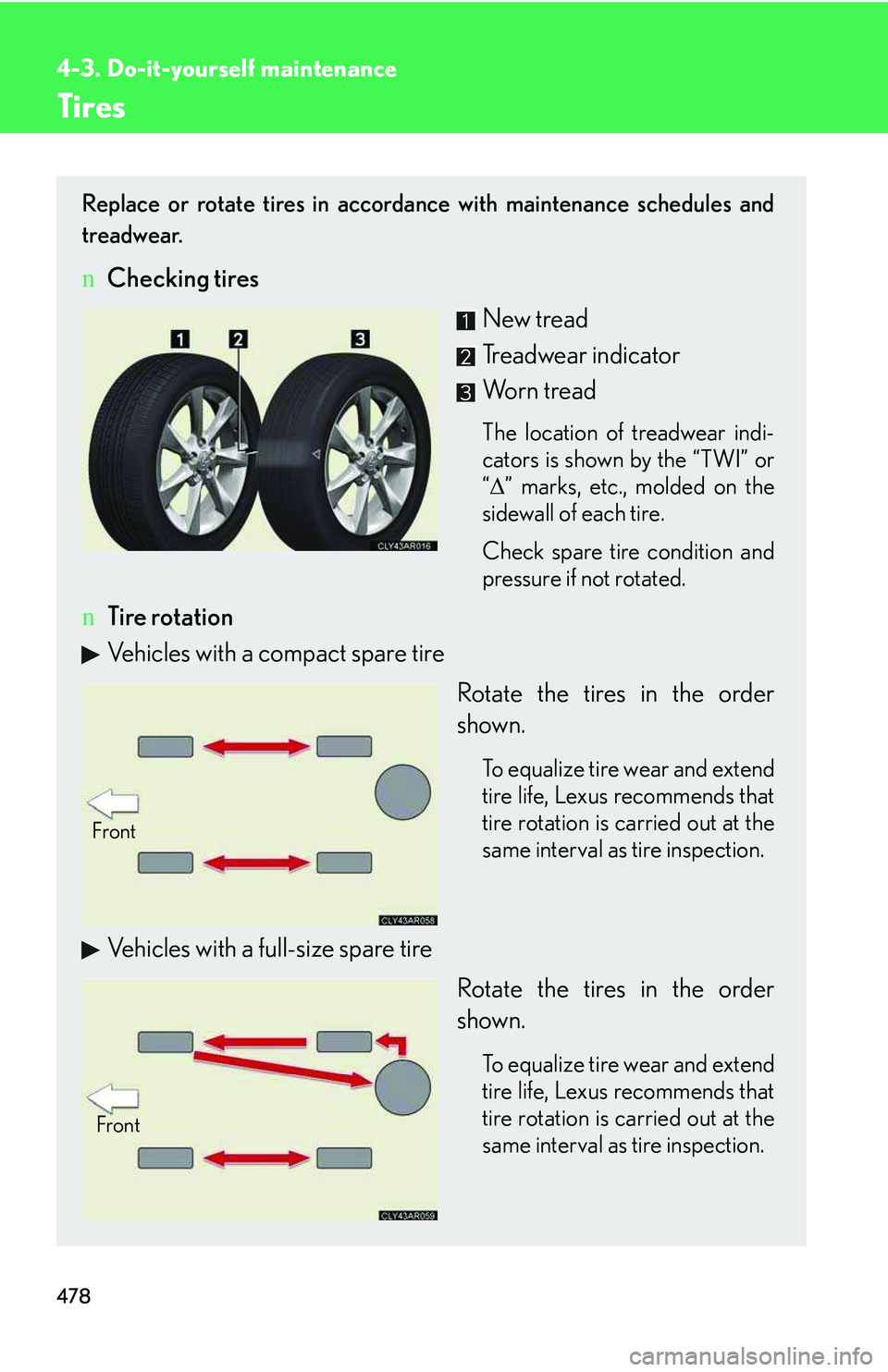
478
4-3. Do-it-yourself maintenance
Tires
Replace or rotate tires in accordance with maintenance schedules and
treadwear.
nChecking tires
New tread
Treadwear indicator
Worn tread
The location of treadwear indi-
cators is shown by the “TWI” or
“�∆” marks, etc., molded on the
sidewall of each tire.
Check spare tire condition and
pressure if not rotated.
nTire rotation
Vehicles with a compact spare tire
Rotate the tires in the order
shown.
To equalize tire wear and extend
tire life, Lexus recommends that
tire rotation is carried out at the
same interval as tire inspection.
Vehicles with a full-size spare tire
Rotate the tires in the order
shown.
To equalize tire wear and extend
tire life, Lexus recommends that
tire rotation is carried out at the
same interval as tire inspection.
Front
Front
Page 549 of 821
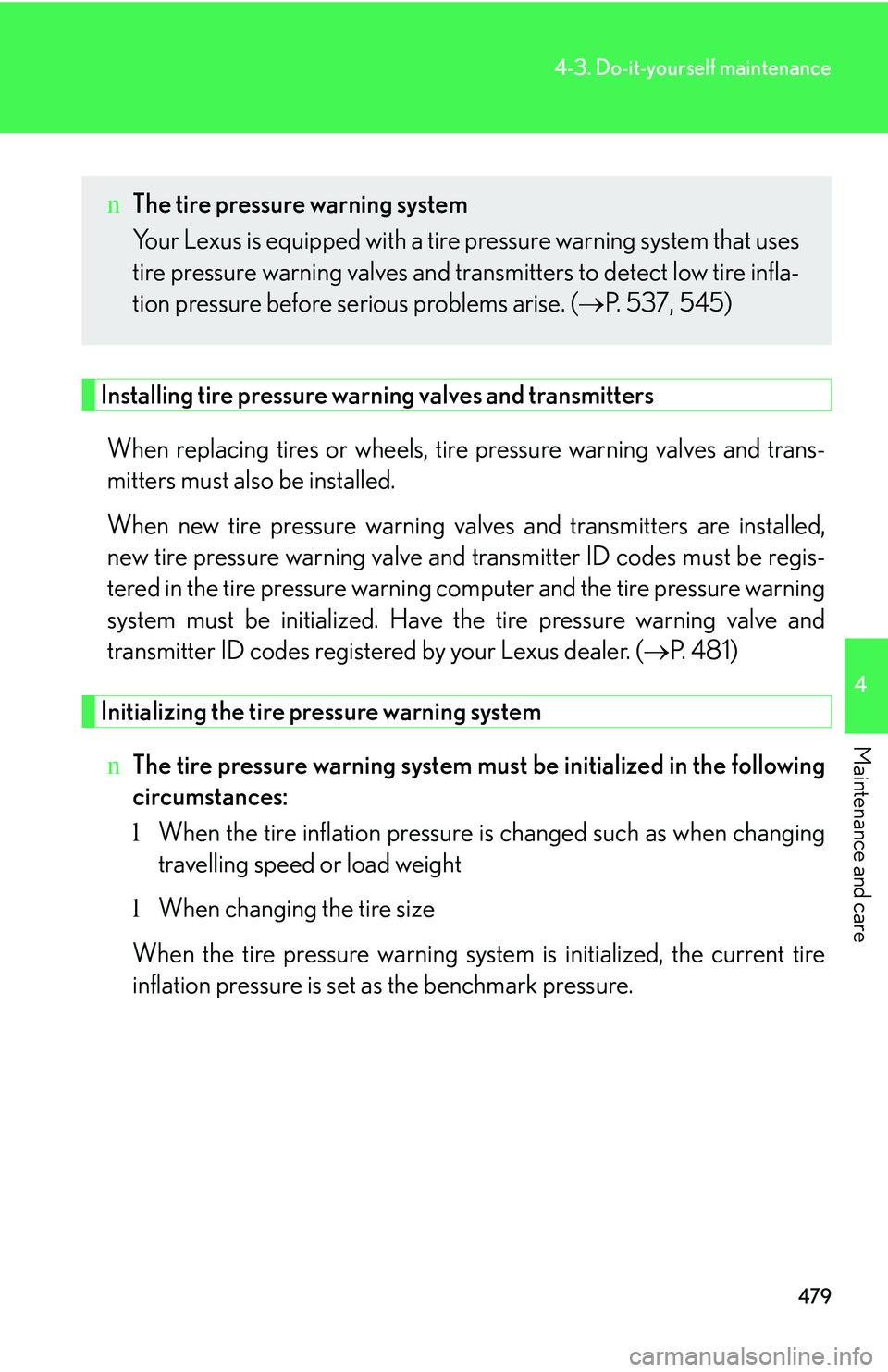
479
4-3. Do-it-yourself maintenance
4
Maintenance and care
Installing tire pressure warning valves and transmitters
When replacing tires or wheels, tire pressure warning valves and trans-
mitters must also be installed.
When new tire pressure warning valves and transmitters are installed,
new tire pressure warning valve and transmitter ID codes must be regis-
tered in the tire pressure warning computer and the tire pressure warning
system must be initialized. Have the tire pressure warning valve and
transmitter ID codes registered by your Lexus dealer. (�→P. 4 8 1 )
Initializing the tire pressure warning system
nThe tire pressure warning system must be initialized in the following
circumstances:
lWhen the tire inflation pressure is changed such as when changing
travelling speed or load weight
lWhen changing the tire size
When the tire pressure warning system is initialized, the current tire
inflation pressure is set as the benchmark pressure.
nThe tire pressure warning system
Your Lexus is equipped with a tire pressure warning system that uses
tire pressure warning valves and transmitters to detect low tire infla-
tion pressure before serious problems arise. (�→P. 537, 545)
Page 550 of 821
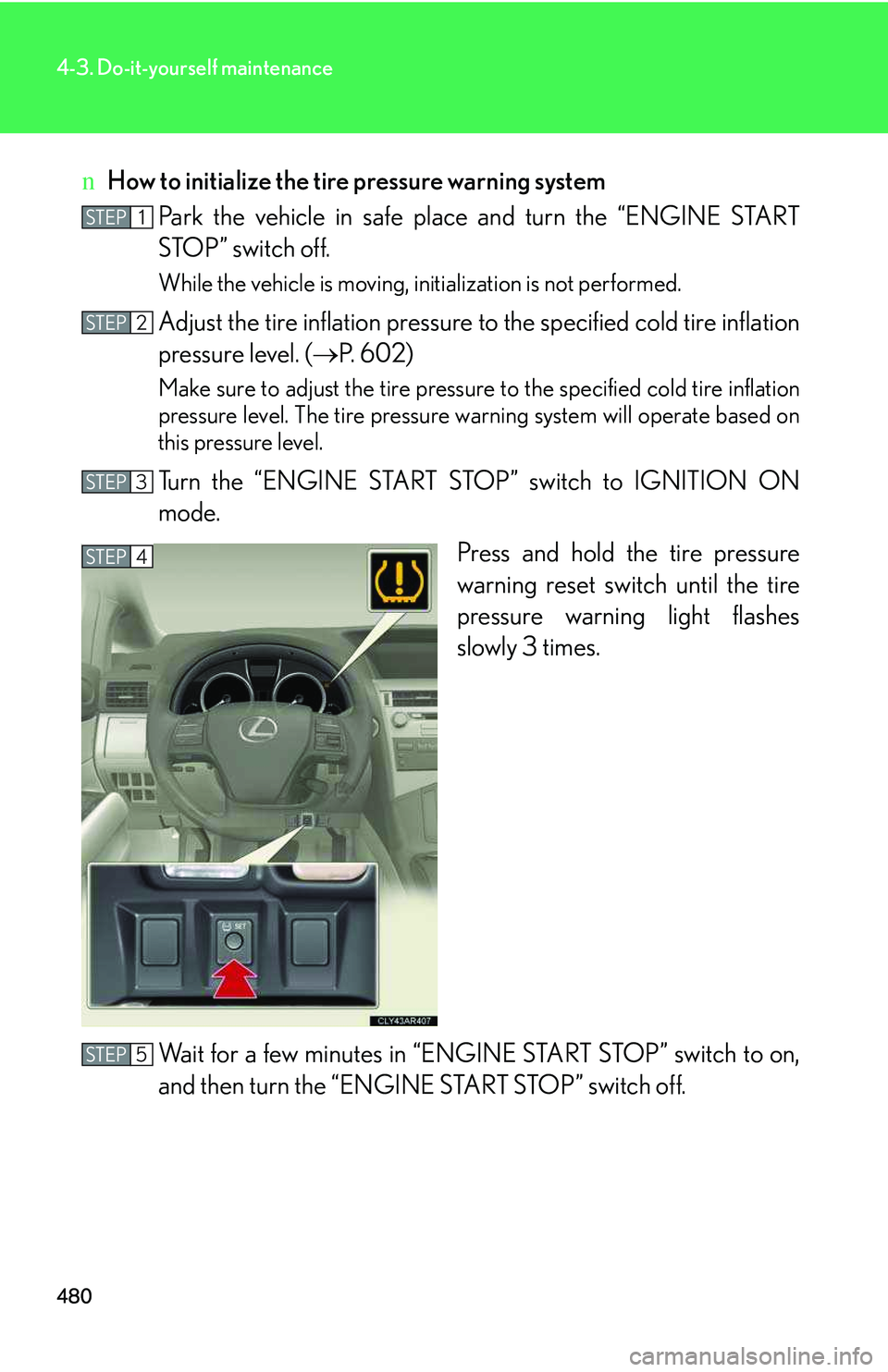
480
4-3. Do-it-yourself maintenance
nHow to initialize the tire pressure warning system
Park the vehicle in safe place and turn the “ENGINE START
STOP” switch off.
While the vehicle is moving, initialization is not performed.
Adjust the tire inflation pressure to the specified cold tire inflation
pressure level. (�→P. 6 0 2 )
Make sure to adjust the tire pressure to the specified cold tire inflation
pressure level. The tire pressure warning system will operate based on
this pressure level.
Turn the “ENGINE START STOP” switch to IGNITION ON
mode.
Press and hold the tire pressure
warning reset switch until the tire
pressure warning light flashes
slowly 3 times.
Wait for a few minutes in “ENGINE START STOP” switch to on,
and then turn the “ENGINE START STOP” switch off.
STEP1
STEP2
STEP3
STEP4
STEP5